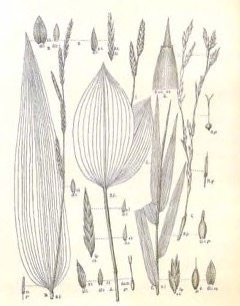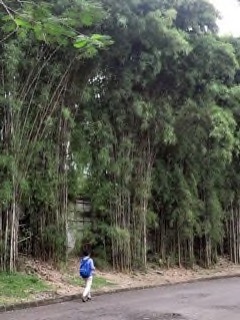 |
|
http://www.edibleplants.org |
 |
| Wibowo Djatmiko (Wie146) wikimedia.org |
Translate this page:
Summary
Monastery Bamboo or also known as Thai Bamboo, Thyrsostachys siamensis, is native to Yunnan, Myanmar, Laos, Thailand, and Vietnam. It is a perennial, evergreen, clumping bamboo that grows about 7 - 13 m in height and 60 mm in culm diameter. The culms are erect, bright green when young and turns yellowish brown upon maturity, with thick wall and prominent nodes. It is cylindrical with a triangular blade. T. siamensis is one of the most useful bamboos within its native range, being utilized for food use, as construction material, and for many other uses. This species has no medicinal value. Young shoots are cooked and eaten as a vegetable. Plant is propagated by division.
Physical Characteristics

 Thyrsostachys siamensis is an evergreen Bamboo growing to 10 m (32ft) by 4 m (13ft) at a fast rate.
Thyrsostachys siamensis is an evergreen Bamboo growing to 10 m (32ft) by 4 m (13ft) at a fast rate.
See above for USDA hardiness. It is hardy to UK zone 10.
Suitable for: light (sandy), medium (loamy) and heavy (clay) soils, prefers well-drained soil and can grow in nutritionally poor soil. Suitable pH: mildly acid and neutral soils and can grow in very acid soils.
It cannot grow in the shade. It prefers moist soil.
UK Hardiness Map
US Hardiness Map
Synonyms
Bambusa regia Thomson ex Munro Bambusa siamensis Kurz ex Munro Thyrsostachys regia (Thomson ex Munro
Plant Habitats
Edible Uses
Edible Parts: Shoots
Edible Uses:
Young shoots - cooked and eaten as a vegetable[310 ]. They are considered to be among the best of bamboo shoots[310 ].
References More on Edible Uses
Medicinal Uses
Plants For A Future can not take any responsibility for any adverse effects from the use of plants. Always seek advice from a professional before using a plant medicinally.
None known
References More on Medicinal Uses
The Bookshop: Edible Plant Books
Our Latest books on Perennial Plants For Food Forests and Permaculture Gardens in paperback or digital formats.

Edible Tropical Plants
Food Forest Plants for Hotter Conditions: 250+ Plants For Tropical Food Forests & Permaculture Gardens.
More

Edible Temperate Plants
Plants for Your Food Forest: 500 Plants for Temperate Food Forests & Permaculture Gardens.
More

More Books
PFAF have eight books available in paperback and digital formats. Browse the shop for more information.
Shop Now
Other Uses
Basketry Biomass Fuel Furniture Paper Shelterbelt Soil stabilization Wood
Agroforestry Uses: The plant is cultivated to provide a shelter from the wind[310 ]. A closely spaced deep-rooting pioneer species, it can be used to provide permanent vegetation cover for soil conservation and erosion control[537 ]. Other Uses The culms are light, strong and straight[633 ]. They are used in house construction and for general household uses, as well as providing raw material for cottage industries[310 ]. The culms are also widely used to make baskets, chopsticks, umbrella and broom handles, handicrafts, fishing rods and they serve as raw material for paper pulp and as fuel[310 ]. This species is often used to produce umbrella handles for people of high rank and status, as well as for monks and priests[146 ]. Once harvested, the culms are traditionally submerged for 10 - 20 days in running water to reduce starch and sugar contents, and subsequently cleaned, polished and dried. For furniture making, the culms are fire cured, which requires much skill to avoid damage[310 ].
Special Uses
Carbon Farming Food Forest
References More on Other Uses
Cultivation details
Industrial Crop: Biomass Management: Managed Multistem Regional Crop
A plant of the moist tropics where it is generally found at elevations from 300 - 400 metres[310 ]. It grows best in areas where annual daytime annual temperatures are within the range 20 - 29°c, though it can tolerate 15 - 34°c[418 ]. It prefers a mean annual rainfall of 1,000 - 2,000mm, but tolerates 600 - 4,500mm[418 ]. It is found in areas both with and without a distinct dry season[418 ]. Succeeds in full sun and in light shade[418 ]. Prefers a heavy soil[418 ]. Often found in poor soils in the wild, though it can tolerate a range of soils if they are well drained[310 ]. Prefers a pH in the range 6 - 6.5, tolerating 5.5 - 7[418 ]. Bamboos have an interesting method of growth. Each plant produces a number of new stems annually - these stems grow to their maximum height in their first year of growth, subsequent growth in the stem being limited to the production of new side branches and leaves. In the case of some mature tropical species the new stem could be as much as 30 metres tall, with daily increases in height of 30cm or more during their peak growth time. This makes them some of the fastest-growing species in the world[K ]. In natural populations the plant produces young shoots during the rainy season. Good years, when many new shoots are produced, alternate with poor years with many fewer new shoots[310 ]. Generally, more shoots are produced if the rain is abundant[310 ]. A clump is considered as good if it has 30 culms on average, but clumps may have up to 100 culms[310 ]. In Thailand, a 3-year-old plantation, raised from seeds, produced on average 38 culms per clump with an average diameter of 14 - 23mm, of which 28 culms per clump were harvestable on average[310 ]. Bamboos in general are usually monocarpic, living for many years before flowering, then flowering and seeding profusely for a period of 1 - 3 years before usually dying. Flowering is sporadic and gregarious. After flowering, the culms usually die. Gregarious flowering is rare and the flowering cycle is not known[310 ]. Spacing: 30-40 ft. (9-12 m).
Carbon Farming
-
Industrial Crop: Biomass
Three broad categories: bamboos, resprouting woody plants, and giant grasses. uses include: protein, materials (paper, building materials, fibers, biochar etc.), chemicals (biobased chemicals), energy - biofuels
-
Management: Managed Multistem
Regularly removing some multiple stems. A non-A non-destructive management systems maintaining the soil organic carbon.
-
Regional Crop
These crops have been domesticated and cultivated regionally but have not been adopted elsewhere and are typically not traded globally, Examples in this broad category include perennial cottons and many nuts and staple fruits.
References Carbon Farming Information and Carbon Sequestration Information
Temperature Converter
Type a value in the Celsius field to convert the value to Fahrenheit:
Fahrenheit:
The PFAF Bookshop
Plants For A Future have a number of books available in paperback and digital form. Book titles include Edible Plants, Edible Perennials, Edible Trees,Edible Shrubs, Woodland Gardening, and Temperate Food Forest Plants. Our new book is Food Forest Plants For Hotter Conditions (Tropical and Sub-Tropical).
Shop Now
Plant Propagation
Seed - when stored at room temperature, the seeds gradually lose viability over a period of 12 - 18 months[310 ]. In cool storage at 2 - 4°c, good viability is retained for at least two years[310 ]. The seed is best sown fresh, when it germinates within days, with 90 - 95% of the seeds sprouting[310 ]. Rhizome cuttings. The cuttings are taken from 1-year-old culms and comprise a length of rhizome with roots plus a culm that can be up to 1 metre long. This is planted in a nursery for 2 - 3 months and then transplanted to the field in the rainy season. In general, 10 rhizome cuttings can be taken from a 5 - 6-year-old clump, retaining 4 - 5 one-year-old culms in the clump[310 ].
Other Names
If available other names are mentioned here
Native Plant Search
Search over 900 plants ideal for food forests and permaculture gardens. Filter to search native plants to your area. The plants selected are the plants in our book 'Plants For Your Food Forest: 500 Plants for Temperate Food Forests and Permaculture Gardens, as well as plants chosen for our forthcoming related books for Tropical/Hot Wet Climates and Mediterranean/Hot Dry Climates. Native Plant Search
Found In
Countries where the plant has been found are listed here if the information is available
Weed Potential
Right plant wrong place. We are currently updating this section.
Please note that a plant may be invasive in one area but may not in your area so it’s worth checking.
Conservation Status
IUCN Red List of Threatened Plants Status : This taxon has not yet been assessed

Growth: S = slow M = medium F = fast. Soil: L = light (sandy) M = medium H = heavy (clay). pH: A = acid N = neutral B = basic (alkaline). Shade: F = full shade S = semi-shade N = no shade. Moisture: D = dry M = Moist We = wet Wa = water.

Expert comment
Author
Gamble
Botanical References
Links / References
For a list of references used on this page please go here
A special thanks to Ken Fern for some of the information used on this page.
Readers comment
| Add a comment |
|
If you have important information about this plant that may help other users please add a comment or link below. Only comments or links that are felt to be directly relevant to a plant will be included. If you think a comment/link or information contained on this page is inaccurate or misleading we would welcome your feedback at [email protected]. If you have questions about a plant please use the Forum on this website as we do not have the resources to answer questions ourselves.
* Please note: the comments by website users are not necessarily those held by PFAF and may give misleading or inaccurate information.
To leave a comment please Register or login here All comments need to be approved so will not appear immediately.
|
Subject : Thyrsostachys siamensis
|
|
|
|